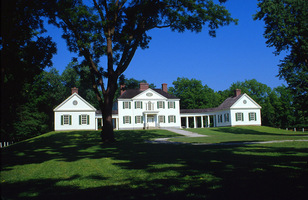
The Ohio River’s most famous island, Blennerhassett, lies two miles west of Parkersburg. It is four miles long, and its 381 acres make it the river’s fifth-largest island.
Blennerhassett was created sometime after A.D. 1300, when the river cut an additional channel north of the main channel. Located on a major stream furnishing food, water, and transportation, the island invited human settlement. Prehistoric Indians occupied the island until about 1680. They eventually cleared most of it to grow corn and lived in villages of structures covered with reed mats or bark. Twentieth-century excavations have revealed Blennerhassett Island to be one of the region’s richest archeological sites.
Blennerhassett’s recorded history begins with a mention in the 1765 journal of the Indian trader George Croghan. A 1766 traveler noted the Delaware chief Nemacolin’s cabin on the island which for that reason was called ‘‘Nemacolin’s Island’’ in following years. It was also known as Belpre Island. The island was farmed by New Englanders during the Ohio Valley’s 1791–95 Indian war. They erected two blockhouses for protection, transforming the island into a business center by building a store and two floating gristmills.
The island’s most momentous chapter opened with the 1798 arrival of Harman and Margaret Blennerhassett, wealthy Irish aristocrats fleeing political persecution and personal scandal. Their years on the island, while brief, were charged with excitement and high style. The couple’s mansion gained the reputation of the West’s most beautiful home. In 1805–06, they allowed their estate to become headquarters for Aaron Burr’s military expedition to the Southwest, an episode that raised the island to national renown and awarded it a permanent footnote in U.S. history. Eventually it became the subject of a short story by Nathaniel Hawthorne, a poem by Walt Whitman, paintings of Eastern artists, and two New York operas. The Blennerhassetts fled the island when Burr’s scheme collapsed.
Despite its notoriety, Blennerhassett Island led a sleepy farming existence until 1886 when a park, which lasted through 1912, was built on its upper end. The boxer ‘‘Gentleman Jim’’ Corbett competed at the park, as did the Cincinnati Reds, Brooklyn Dodgers, and Pittsburgh Pirates. As a 1920s moonshining center, Blennerhassett become the scene of occasional raids and bloody frays during Prohibition.
Today, Blennerhassett Island is a state historical park. With the reconstructed Blennerhassett mansion providing an elegant backdrop, the island welcomes 40,000 visitors a year. The Blennerhassett Island Historic District was added to the National Register of Historic Places in 1972.
Read the National Register nomination.
Last Revised on October 18, 2023
Related Articles
Sources
Bennett, Emerson. The Traitor or the Fate of Ambition. Cincinnati: U.P. James, 1860.
Lowther, Minnie Kendall. Blennerhassett Island in Romance and Tragedy. Rutland, VT: Tuttle Pub., 1939.
Swick, Ray. "Harman Blennerhassett: An Irish Aristocrat on the American Frontier." Ph.D. diss., Miami University, 1978.
Cite This Article
e-WV: The West Virginia Encyclopedia "Blennerhassett Island." e-WV: The West Virginia Encyclopedia. 18 October 2023. Web. 26 July 2024.


Comments?
There aren't any comments for this article yet.
Click here to read and contribute to the discussion →